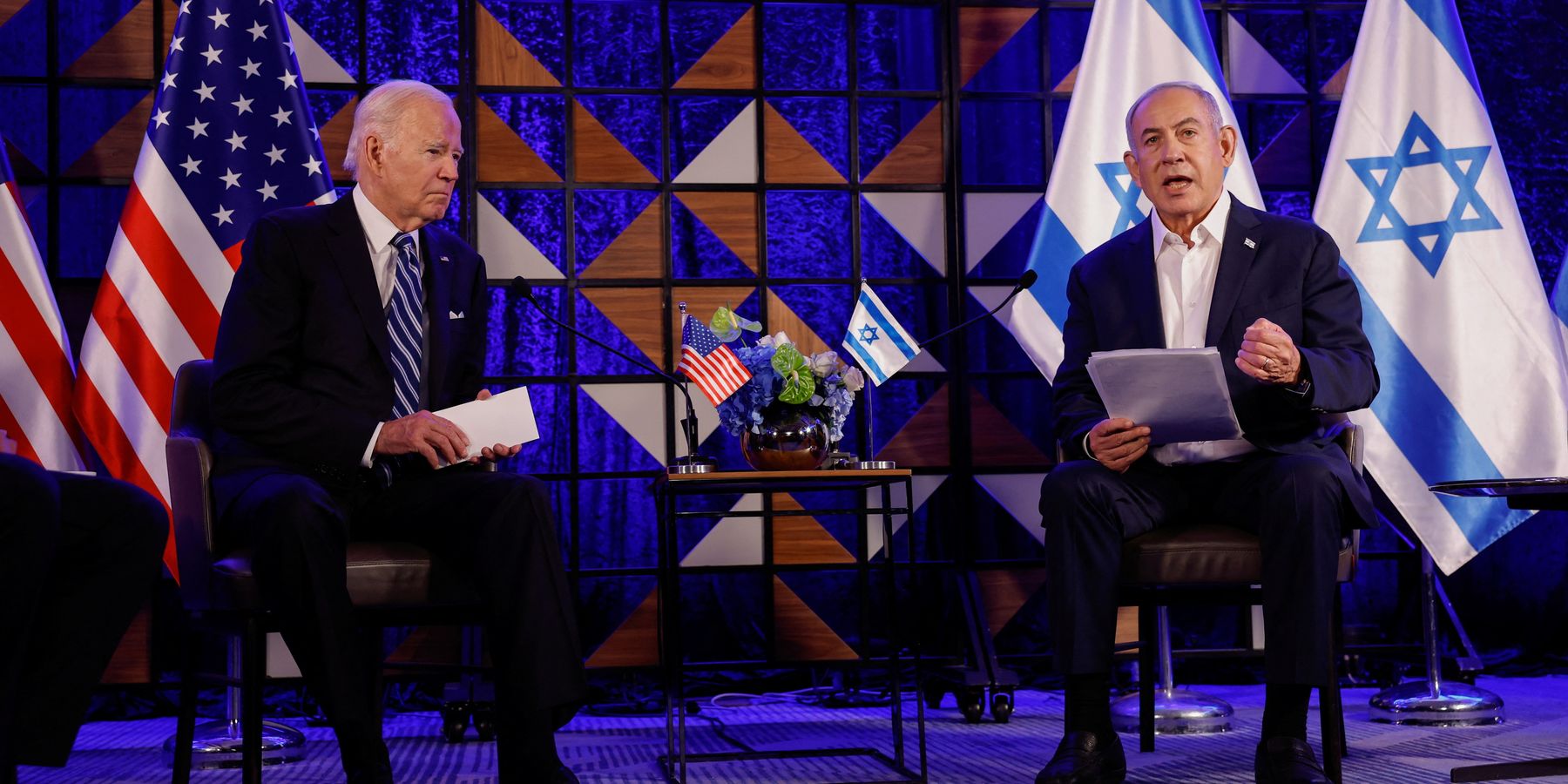In a December 8 story that seems to have received little attention in western press coverage of Israel’s expanding military campaign in Gaza was this nugget of information: Israel’s military expects combat operations to continue until the end of January, “followed by a three-to-nine-month lower grade insurgency.” Reported by the Jerusalem Post, an English daily whose correspondents appear to have good ties to the Israel Defense Forces, this prediction likely rang alarm bells in the Biden administration. The White House is well aware of Prime Minister Benjamin Netanyahu’s promise to do whatever it takes to “destroy” Hamas. But beyond doubting that this goal is feasible, US officials likely have concluded that Israel is not capable of pursuing its campaign in Gaza without killing many more Palestinian civilians, or is not ready to do so. With the threat of disease and starvation growing as Gazans flee to the south in a nearly hopeless search for safety, the prospect of a major crisis in US-Israel relations is growing. Thus while Israeli leaders applauded the White House’s veto of last week’s United Nations Security Council resolution calling for an immediate ceasefire, they know that the Biden administration supports a wider political and diplomatic approach that Israel’s current government—as Netanyahu has stated—totally rejects.
On December 12, President Joe Biden showed clear dissatisfaction with the Israeli government and Netanyahu. In remarks to donors, Biden reportedly said that Israel is losing support around the world because of how it is conducting the Gaza war. He also reportedly said that Netanyahu “has to change” and that the Prime Minister rejects the two-state solution on which the president has staked his approach to the Palestinian-Israeli conflict. This gap between the US and Israeli positions on the Gaza crisis is partly a consequence of the contradictory signals that the White House sent Israel in the first weeks following Hamas’s October 7 assault. In addition to Biden’s “bear hug” of Netanyahu—a leader for whom he has little love—US officials, including the President, signaled a kind of muddled ambivalence when it came to pressing Israel to limit the ferocity of its bombing campaign.
In addition to Biden’s “bear hug” of Netanyahu—a leader for whom he has little love—US officials, including the President, signaled a kind of muddled ambivalence when it came to pressing Israel to limit the ferocity of its bombing campaign.
Still, it seemed that the November 24-December 1 truce might open the door to a wider diplomatic initiative led by the United States and backed by its Arab allies. But the efforts of the White House to prevent the resumption of hostilities failed for many reasons, not least of which was Israel’s determination to “finish the job.” Fearing the worst, the White House secured a promise from Israel that it would take new measures to limit civilian casualties. Secretary of State Antony Blinken’s December 7 statement, however, that “there does remain a gap between…the intent to protect civilians and the actual results that we’re seeing on the ground” underscored the administration’s unhappiness with Israel’s ensuing assault on southern Gaza. And it pointed to a far bigger problem, namely the White House’s failure so far to secure an Israeli approval of a postwar plan for Gaza that involves the Palestinian Authority. For Washington, Netanyahu’s singular and relentless focus on military tactics represents a strategic nightmare.
National Rage and Political Evasion
There are at least two related reasons why Netanyahu’s government has steadfastly avoided any hint of an ultimate political strategy toward Gaza.
First, there is the impact of the continuing hostage crisis on the Israeli public. The vivid testimonies coming from some of the 105 hostages who were freed during the humanitarian pause have filled Israel’s media, magnifying the outrage generated by the October 7 atrocities. Shocking accounts of Hamas’s use of sexual violence against women and men has steeled the resolve of Israelis to support the war. That it took some two months for UN agencies and other international groups to clearly condemn the reported assaults and to call for investigations has only reinforced Israelis’ view that they should circle the wagons and defy international pressures for a ceasefire. With the furious public fixated on revenge, Israel’s government has felt no pressure to articulate any agenda beyond destroying Hamas.
Second, by creating a five-member war cabinet—including opposition leaders Benny Gantz and Gadi Eisenkot, a former general whose son was killed on December 7 in Gaza—Netanyahu has restricted decision-making to a small group that has only one game plan for which he, of course, is the chief spokesman. But while this arrangement may allow Netanyahu to survive another day or week, or perhaps months, it has not prevented ultra-hardline members of the larger cabinet to issue calls for expelling Palestinians from Gaza. The Prime Minister’s spokesman has denied that Israel has any such intentions. But in light of the war cabinet’s reluctance to address the “day after” question—not to mention the reality that some 1.8 million Gazans have fled their homes—Arab officials have expressed growing fears that Israel is pursuing a new Nakba. That Vice President Kamala Harris has warned that “under no circumstances” will the United States tolerate the forced relocation of Palestinians from Gaza suggests that the Biden administration shares these worries.
Against the background of Israel’s expanding operations in northern and southern Gaza, the administration has been trying to mobilize regional support for a plan to place postwar Gaza under the control of a “revitalized” Palestinian Authority.
Indeed, against the background of Israel’s expanding operations in northern and southern Gaza, the administration has been trying to mobilize regional support for a plan to place postwar Gaza under the control of a “revitalized” Palestinian Authority (PA) so that, in Blinken’s words, “we can get on the path to a just, lasting and secure peace for Israelis and Palestinians.” Seeing such an effort as a step toward some kind of Palestinian statehood (a goal that President Biden has repeatedly endorsed over the past six weeks), Netanyahu has categorically rejected any notion of putting Gaza under the PA’s supervision. Yet his failure to clarify the ultimate goal of Israel’s military campaign is feeding concerns in Israel that despite explicit reassurances of staunch US support for the military campaign—most recently telegraphed in the White House’s decision to bypass Congress in resupplying Israel with 14,000 rounds of tank munitions—the United States and Israel are on a collision course.
The Government Should “Stop Playing Politics”
Concerns over such a clash have prompted calls from Israeli opinion leaders for Netanyahu’s government to articulate a “day after” agenda. While as might be predicted, some of these calls have come from the left or center left, more conservative figures have chimed in. Writing in the Jerusalem Post on December 8, one such commentator, Yaakov Katz, reminded his readers that in addition to warnings from Harris and Blinken, Secretary of Defense Lloyd Austin III cautioned Israel that by pursuing military operations killing thousands of civilians, Israel may drive Gazans into the hands of Hamas and thus courting “strategic defeat.” According to Katz, such US statements demonstrate that “while the US has held off on calling for a comprehensive cease fire…there is no doubt in Jerusalem that such a call is growing closer”—and with it, a potential clash over the fundamental question of where Gaza will fit into a revived peace process. To avoid or at least minimize this clash, Katz argued that “Israel needs to put forward a plant for the ‘day after’ that “includes some sort of diplomatic engagement with the Palestinian Authority.” At the same time, Katz contended that Americans need to undergo their own transformation by not creating unrealistic expectations about a two-state solution in the absence of “an Anwar Sadat-like leader on the Palestinian side.”
Katz apparently does not feel that Netanyahu can be trusted to prevent such a clash, as the Prime Minister is only “playing politics.” But given the still-enormous gap between US and Israeli positions on the future of Palestinians in both Gaza and the West Bank, it is difficult to imagine how the author’s call for Israel to “coordinate with the US” on devising a common plan would amount to little more than an exercise in kicking the can down the road. This, of course, is what the author advocates. But it is far from clear that the Biden administration ultimately will be prepared to put a band aid on what is a deepening diplomatic wound between the United States and Israel.
Despite or perhaps because of these clashing visions, it appears that Israel’s war cabinet has concluded that it is time to begin fashioning some kind of diplomatic-political strategy. Commenting on the subject, one Israeli analyst noted that while Netanyahu recently has formed a committee to decide on strategies for postwar Gaza, “devising a feasible plan that can gain acceptance in this current government will be a significant challenge.”
For Israel, the United States, and the region, the other important “day after” could be on the morning following new elections and the subsequent formation of a new Israeli government.
That is putting it mildly. Giving a committee the task of settling on strategies for Gaza after the war feels more like a bureaucratic evasion than a serious effort to come to grips with another fundamental strategic question at hand. It may well be that this Israeli government will not be able to seriously address this challenge. For Israel, the United States, and the region, the other important “day after” could be on the morning following new elections and the subsequent formation of a new Israeli government. But the lasting tremors of October 7 could produce a government that is as far right as the current one. Regardless of when this other day after happens, it is clear that the United States and Israel are at loggerheads.
An Endless Insurgency?
However real, the brewing conflict between the United States and Israel has been obscured by a basic contradiction in the Biden administration’s approach to the Gaza conflict. On the one hand, it seems evident that the administration expects Israel to deal Hamas a decisive military blow that will make it possible, with the backing of Arab states and the international community, to pursue new efforts to broker Palestinian-Israeli peace. On the other hand, the calamitous effects of Israel’s military campaign on Gaza’s civilian population have created a diplomatic dilemma for the administration that it cannot tolerate much longer. Thus it is possible that sooner rather than later the White House will support a revised ceasefire plan at the United Nations.
It is precisely this prospect that has impelled Israel to accelerate its military operations in the hope that it can dismantle Hamas’s military and political infrastructure before US patience runs out. Yet, even if it achieves this goal, Israel may face a Hamas insurgency that could last months, if not years. It is hard to imagine how this expectation can be squared with any serious strategy for addressing the political future of Gaza. Moreover, as several analysts have argued, while Israeli leaders hope that Gazans will blame Hamas’s leaders for the current catastrophe as much as if not more than they blame Israel, the continuing onslaught may spur many more young Gazans to join Hamas, thus spawning a guerilla campaign that could have Israeli soldiers fighting and dying in an endless battle. Such an outcome would represent a victory for Hamas or whatever group succeeds it, especially if it unfolds in the maelstrom of a wider regional war.
While Israeli leaders hope that Gazans will blame Hamas’s leaders for the current catastrophe as much as if not more than they blame Israel, the continuing onslaught may spur many more young Gazans to join Hamas.
For the United States and its Arab allies, the possibility of this unwarranted scenario is as real as it is unacceptable. To avoid it, the Biden administration might try to fashion a diplomatic achievement, perhaps by brokering a breakthrough in Israeli-Saudi relations. It may be that the prospect of normalizing ties with Saudi Arabia will shake up Israel’s traumatized polity in ways that open the door for the kind of solutions not currently on the horizon. But if there is going to be an Abraham Accords Round Two—one that is about real peacemaking rather than the joys of celebrating Chanukah in Dubai—President Biden will have to back an Israeli-Palestinian game plan that may cause unprecedented tensions in the US-Israeli strategic partnership.
This article has been republished with permission from Arab Center Washington DC.
















